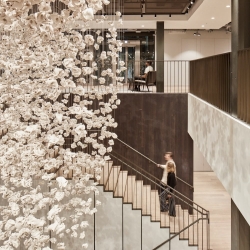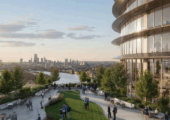 In a world where how we work keeps evolving, it’s worth stepping back to ask: What are you about as an organisation? Not your product. Not your structure. Your purpose. Your direction. Your why. What are you ultimately trying to achieve as an organisation and why? What’s the bigger outcome you’re working toward? How do you want your people, your customers, your industry to be different because you exist? These aren’t just philosophical questions. They’re practical ones because your answers shape everything including your strategy, your team structures and your culture. It also shapes a seemingly straightforward question on your workplace strategy.
In a world where how we work keeps evolving, it’s worth stepping back to ask: What are you about as an organisation? Not your product. Not your structure. Your purpose. Your direction. Your why. What are you ultimately trying to achieve as an organisation and why? What’s the bigger outcome you’re working toward? How do you want your people, your customers, your industry to be different because you exist? These aren’t just philosophical questions. They’re practical ones because your answers shape everything including your strategy, your team structures and your culture. It also shapes a seemingly straightforward question on your workplace strategy.
Once you know your organisation’s purpose, then, and only then, can you ask: What is the function of your office? Why do you have one? What do you need from it, really? Is it a place to brainstorm together, recharge the team’s energy, and build relationships? Or is it a quiet zone for deep work and focused execution? Is it a cultural anchor or a logistical one? Is it used intentionally or just out of habit? Is it all the above? Or just elements.
Too often, we treat the office as a default, a line on the budget, a legacy of how things used to be. For well over a decade, we have talked about how hybrid, remote, and asynchronous work and how it continues to evolve, particularly since the pandemic.
I would even argue we have started to get bored with the conversation because we have been talking about it for so long and don’t seem to be any closer to a real answer. And I think the reason why we don’t have an answer is because we have not done the ground work of defining our purpose and using that to define why we want and need an office. Form follows function, and function should follow purpose. So, if your purpose has changed (which it most likely has because the world has changed), your office should too.
We have the opportunity (and responsibility) to reimagine the workplace as something purposeful, flexible, and human. We can do that by linking our organisational purpose with the environment that will enables us to achieve that purpose.
It’s not about being remote first, office first, or hybrid by default. It is not about choosing sides or how many days a week a person should be in a certain space. It’s about being clear on who you are, what you’re trying to do, and what environment best enables that for your people and your mission.
So the question isn’t, “Should we return to the office?”, but “what role should the office play based on what we value, where we’re headed, and how we want to work?” The answers won’t be the same for everyone – that is where neurodiversity comes in and that’s the point.
If you’re not sure, start with visioning.
If the purpose feels fuzzy, you’re not alone. We are experiencing a level and rate of change, we have never been faced with before. That is how visioning can help us. Visioning is about creating space – mental, conversational, and often physical. It’s about stepping back from the day to day and imagine the future you want to create. Not in terms of outputs or KPIs, but in terms of meaningful impact.
Ask your leadership team and your wider organisation:
- What will be true in the world if we’re successful?
- How will our people feel?
- What will our customers say about us?
- What won’t exist anymore because we solved it?
Hold a session with your leadership team and invite diverse voices; those you would not normally invite. Step away from the to do list and zoom out. Use stories, metaphors, drawings, anything that helps pull ideas out of the abstract.
It’s not about getting the wording perfect. It’s about getting clear on direction because once you know where you’re headed, everything else from your strategy, your culture, even your office can line up behind it.
So start with purpose, not with policies or floorplans. At the end of the day, the question is not “where” we work, it’s “why” we work and what kind of world we are trying to build together.
Jennifer Bryan is a published author, speaker and Director of Change and Leadership, who has worked with nearly 40 different organisations across multiple industries. She is also a Non Executive Board Member of the ACMP (Association of Change Management Professionals) UK Chapter. She believes in helping people – in whatever capacity she can – by making sure people are thought of first, last and throughout change projects and programmes. She has created a unique leading change framework, the ABChange Model, and uses her commercial insight to help lead people in change. Jennifer is author of Leading People in Change – A practical guide.
Image: Morey Smith















October 8, 2025
The real reason why your workplace strategy isn’t working
by Jennifer Bryan • Comment, JB, Workplace
Once you know your organisation’s purpose, then, and only then, can you ask: What is the function of your office? Why do you have one? What do you need from it, really? Is it a place to brainstorm together, recharge the team’s energy, and build relationships? Or is it a quiet zone for deep work and focused execution? Is it a cultural anchor or a logistical one? Is it used intentionally or just out of habit? Is it all the above? Or just elements.
Too often, we treat the office as a default, a line on the budget, a legacy of how things used to be. For well over a decade, we have talked about how hybrid, remote, and asynchronous work and how it continues to evolve, particularly since the pandemic.
I would even argue we have started to get bored with the conversation because we have been talking about it for so long and don’t seem to be any closer to a real answer. And I think the reason why we don’t have an answer is because we have not done the ground work of defining our purpose and using that to define why we want and need an office. Form follows function, and function should follow purpose. So, if your purpose has changed (which it most likely has because the world has changed), your office should too.
We have the opportunity (and responsibility) to reimagine the workplace as something purposeful, flexible, and human. We can do that by linking our organisational purpose with the environment that will enables us to achieve that purpose.
It’s not about being remote first, office first, or hybrid by default. It is not about choosing sides or how many days a week a person should be in a certain space. It’s about being clear on who you are, what you’re trying to do, and what environment best enables that for your people and your mission.
So the question isn’t, “Should we return to the office?”, but “what role should the office play based on what we value, where we’re headed, and how we want to work?” The answers won’t be the same for everyone – that is where neurodiversity comes in and that’s the point.
If you’re not sure, start with visioning.
If the purpose feels fuzzy, you’re not alone. We are experiencing a level and rate of change, we have never been faced with before. That is how visioning can help us. Visioning is about creating space – mental, conversational, and often physical. It’s about stepping back from the day to day and imagine the future you want to create. Not in terms of outputs or KPIs, but in terms of meaningful impact.
Ask your leadership team and your wider organisation:
Hold a session with your leadership team and invite diverse voices; those you would not normally invite. Step away from the to do list and zoom out. Use stories, metaphors, drawings, anything that helps pull ideas out of the abstract.
It’s not about getting the wording perfect. It’s about getting clear on direction because once you know where you’re headed, everything else from your strategy, your culture, even your office can line up behind it.
So start with purpose, not with policies or floorplans. At the end of the day, the question is not “where” we work, it’s “why” we work and what kind of world we are trying to build together.
Jennifer Bryan is a published author, speaker and Director of Change and Leadership, who has worked with nearly 40 different organisations across multiple industries. She is also a Non Executive Board Member of the ACMP (Association of Change Management Professionals) UK Chapter. She believes in helping people – in whatever capacity she can – by making sure people are thought of first, last and throughout change projects and programmes. She has created a unique leading change framework, the ABChange Model, and uses her commercial insight to help lead people in change. Jennifer is author of Leading People in Change – A practical guide.
Image: Morey Smith